April 24, 2025
0 comments
When it comes to setting up an efficient laboratory or upgrading your medical equipment, one of the most essential tools you’ll need is a reliable centrifuge. Whether you’re running clinical diagnostics, conducting biological research, or handling routine lab tasks, choosing the right centrifuge is critical to maintaining precision, safety, and workflow efficiency.
With so many centrifuge models on the market—ranging from small bench-top units to high-speed refrigerated machines—it can be difficult to know where to start. This comprehensive buying guide will walk you through everything you need to know about centrifuges and help you select the best machine for your needs.
Why Do You Need a Centrifuge?
Centrifuges are used to separate substances of different densities—typically liquids and solids—by spinning them at high speeds. In medical labs, they’re used to separate plasma from blood. In biology, they help isolate DNA, proteins, or organelles. In industrial applications, they are crucial for purifying chemicals or products.
Benefits of Using a Quality Centrifuge
- Accurate sample separation
- Faster processing times
- Improved safety and compliance
- Long-term cost savings due to durability and efficiency
Types of Centrifuges: Which One Do You Need?
Understanding the different types of centrifuges is the first step in making an informed purchase. Here are the most common types:
1. Microcentrifuge
- Use: For small volumes (0.2–2 ml tubes)
- Best for: Molecular biology labs, DNA/RNA extraction
- Speed: Up to 15,000 RPM
- Compact & easy to use
2. Refrigerated Centrifuge
- Use: Keeps samples cool during high-speed spins
- Best for: Temperature-sensitive biological samples like proteins or enzymes
- Includes: Temperature controls down to -10°C or lower
3. High-Speed Centrifuge
- Use: For medium to large sample volumes
- Best for: Research, clinical, and pharmaceutical labs
- Speed: Up to 25,000 RPM
4. Ultracentrifuge
- Use: Extremely high speeds for subcellular particles
- Best for: Advanced research facilities (e.g. virology, proteomics)
- Speed: 50,000–100,000 RPM
5. Clinical Centrifuge
- Use: Standard blood and urine separation
- Best for: Hospitals, diagnostic labs
- User-friendly, fast setup
Rotor Types: Fixed-Angle vs Swing-Bucket
Centrifuge rotors determine how the tubes are held and how samples behave during the spin.
Fixed-Angle Rotor
- Tubes are held at a constant angle (typically 45°)
- Best for: Pelleting particles quickly
- Benefits: Faster separation, higher speed
Swing-Bucket Rotor
- Buckets swing out to horizontal during rotation
- Best for: Even layer separation (e.g., blood components)
- Benefits: Greater versatility for different tube sizes
Some centrifuges come with interchangeable rotors for maximum flexibility.
Key Features to Look For in a Centrifuge
When evaluating different centrifuge models, keep these features in mind:
1. Speed & RCF (Relative Centrifugal Force)
- Make sure the RPM and RCF match your application needs.
- For biology labs: 10,000–15,000 RPM is standard.
- For clinical labs: 3,000–5,000 RPM is typically sufficient.
2. Capacity
- Choose based on the number of tubes and their volume (e.g., 6 × 15ml tubes vs. 24 × 1.5ml tubes).
- For higher sample throughput, look for large-capacity rotors.
3. Temperature Control
- Refrigerated options are critical for sensitive biological samples.
- Choose models with programmable temperature settings.
4. Safety Features
- Lid lock mechanisms
- Imbalance detection
- Automatic shut-off
5. User Interface
- Look for digital displays, customizable programs, and simple controls.
- Touchscreen models offer intuitive navigation.
6. Noise Level
- For quiet lab environments, look for models under 60 dB.
7. Size and Footprint
- Consider your bench space or room layout.
- Some compact models are designed for small labs or mobile setups.
Top Centrifuge Brands and Models on the Market
While many brands offer excellent centrifuges, these are some of the most trusted names:
- Eppendorf – High-quality microcentrifuges and refrigerated options
- Thermo Scientific – Known for durable and high-speed lab centrifuges
- Beckman Coulter – Premium ultracentrifuges for advanced research
- Hettich – Versatile clinical and general-purpose centrifuges
- Ohaus – Reliable entry-level options with intuitive features
Always compare user reviews, warranties, and service support before committing.
Flush-Mounted vs Benchtop vs Floor-Standing Centrifuges
Depending on your lab’s space and purpose, consider these installation styles:
- Benchtop: Best for smaller labs or light usage
- Floor-standing: Ideal for heavy-duty usage or high-volume testing
- Flush-mounted or under-counter: Saves space, blends with cabinetry (less common)
Dimmable, Programmable, and Smart Features
Modern centrifuges often include smart features like:
- Pre-programmed cycles
- Customizable spin profiles
- USB/data export for tracking runs
- Remote monitoring via Wi-Fi
These features can enhance lab efficiency and reproducibility.
Before You Buy: Final Considerations
Before making your final purchase, keep these tips in mind:
- Read reviews from other professionals in your field.
- Check warranty details—ideally 1–3 years for parts/labor.
- Ask about service—can it be repaired locally?
- Ensure certification if required (e.g., CE, ISO, UL listings).
Conclusion: Invest in the Right Centrifuge for Your Lab’s Success
Purchasing the right centrifuge is a vital investment in your lab’s productivity, safety, and accuracy. By understanding the different types, rotors, and essential features, you’ll be well-prepared to make a confident and informed decision.
Whether you’re equipping a hospital, academic lab, or private research facility, the right centrifuge can significantly enhance your operations. Take the time to compare options, prioritize performance, and find a centrifuge that matches your workflow needs.

Leave a Reply